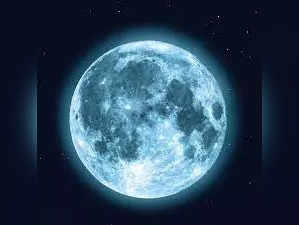
Get ready for an astronomical treat on Wednesday, August 30, 2023, as a remarkable event graces the heavens—a Super Blue Moon. This cosmic occurrence involves the appearance of the second full moon of the month, colloquially known as a "Blue Moon."
While this phenomenon is not a regular event, it takes place every few years due to the moon's approximately 29-day orbit around Earth.
A supermoon is defined by a full moon occurring at or near the date of perigee. To be precise, a supermoon takes place when the full moon appears within 90% of its closest proximity to Earth during a given orbit.
While it's unlikely that most observers will discern the slightly larger size of the Super Blue Moon (despite its name, it won't actually appear blue), the increased brightness will certainly capture attention. Supermoons shine around 14% larger and an impressive 30% brighter compared to the moon during apogee. This added radiance is what truly stands out.
The evening's most opportune time for moon watching aligns with moonrise, particularly during twilight. An extra treat awaits European viewers, as Thursday, August 31, offers a bonus night to witness the moonrise, slightly delayed compared to Wednesday.
For August 31, 2023: In London, sunset is at 7:52 p.m. BST, while moonrise transpires at 8:24 p.m. BST. The full moon reaches its peak at 1:37 a.m. BST. The full moon will achieve its peak at 9:36 p.m. ET, remaining fully visible into August 31
Notably, the term "Blue Moon" doesn't refer to the moon's color; it's mostly the regular hue. The moniker "Blue Moon" dates back to William Shakespeare's time and even earlier. Originating from a religious pamphlet authored by William Roy and Jerome Barlow in the early 1500s, the term was used to denote something unique, rare, or astounding.
Notably, this event is also the third supermoon of the year. Such Super Blue Moons are particularly uncommon, with the previous occurrence taking place in December 2009 and the next expected in August 2032.
"Once in a blue moon" is a frequently employed phrase with a long-standing history. It conveys the idea of something occurring 'not very often' or 'very rarely.' While this expression is often associated with an additional full moon, it has also been applied to depict instances when the moon's appearance takes on a bluish hue due to various circumstances.
Why are Blue Moons so rare?
The moon follows a cycle of approximately 29.5 days. As a result, the occurrence of a full moon is a monthly event. Yet, in exceptional instances, there are moments when two full moons appear within a single month. This phenomenon is known as a blue moon. According to Space.com, these blue moons emerge every two to three years.
While this phenomenon is not a regular event, it takes place every few years due to the moon's approximately 29-day orbit around Earth.
A Super Blue Moon: A Double Delight
What makes this particular Blue Moon truly exceptional is its distinction as the most substantial and brightest "supermoon" of the entire year. The moon follows an elliptical path during its journey around Earth, leading to variations in its distance from our planet. The point nearest to Earth is termed perigee, while the farthest point is referred to as apogee.A supermoon is defined by a full moon occurring at or near the date of perigee. To be precise, a supermoon takes place when the full moon appears within 90% of its closest proximity to Earth during a given orbit.
Appreciating the Magnitude and Luminosity
While it's unlikely that most observers will discern the slightly larger size of the Super Blue Moon (despite its name, it won't actually appear blue), the increased brightness will certainly capture attention. Supermoons shine around 14% larger and an impressive 30% brighter compared to the moon during apogee. This added radiance is what truly stands out.
Prime Viewing Time for the Super Blue Moon
For the optimal experience of a full moon, it's recommended to observe it as it rises soon after sunset during the dusk hours. The Super Blue Moon will achieve its full illumination at precisely 8:37 p.m. EDT on Wednesday, August 30, 2023.The evening's most opportune time for moon watching aligns with moonrise, particularly during twilight. An extra treat awaits European viewers, as Thursday, August 31, offers a bonus night to witness the moonrise, slightly delayed compared to Wednesday.
Moonrise Schedules Across Different Regions
In London, the sun sets at 7:54 p.m. BST, followed by the moonrise at 8:08 p.m. BST. In New York, sunset is at 7:33 p.m. EDT, with moonrise following at 7:45 p.m. EDT. The moment of the full moon's illumination is at 8:37 p.m. EDT. In Los Angeles, the sun sets at 7:23 p.m. PDT, and moonrise occurs at 7:36 p.m. PDT. The full moon's peak illumination happened earlier at 5:37 p.m. PDT.For August 31, 2023: In London, sunset is at 7:52 p.m. BST, while moonrise transpires at 8:24 p.m. BST. The full moon reaches its peak at 1:37 a.m. BST. The full moon will achieve its peak at 9:36 p.m. ET, remaining fully visible into August 31
Appreciating the Enchanting Moon
The night sky offers an array of breathtaking wonders, with the moon taking a prominent place among them. While the progression of lunar phases has been decoded by science, the rarity of events like the Blue Moons continues to captivate our curiosity. This celestial occurrence even inspired the phrase "once in a blue moon." As we approach August 2023, this Blue Moon deserves our fascination and attention.Understanding the Blue Moon Phenomenon
A Blue Moon is characterized by the occurrence of two full moons within a single month. Although full moons usually appear once in every 30-day cycle, a Blue Moon event leads to two occurrences.Notably, the term "Blue Moon" doesn't refer to the moon's color; it's mostly the regular hue. The moniker "Blue Moon" dates back to William Shakespeare's time and even earlier. Originating from a religious pamphlet authored by William Roy and Jerome Barlow in the early 1500s, the term was used to denote something unique, rare, or astounding.
Notably, this event is also the third supermoon of the year. Such Super Blue Moons are particularly uncommon, with the previous occurrence taking place in December 2009 and the next expected in August 2032.
Frequency of Blue Moons
According to NASA, Blue Moons emerge approximately every two and a half years, with the last occurrence in 2020. A seasonal Blue Moon was last observed in 2021. Space reports that the subsequent seasonal Blue Moon is anticipated around August 19, 2024, after the August 30, 2023 event. As per Moon Giant, the following monthly Blue Moon is projected for the end of May 2026.FAQs
What does a blue moon mean?"Once in a blue moon" is a frequently employed phrase with a long-standing history. It conveys the idea of something occurring 'not very often' or 'very rarely.' While this expression is often associated with an additional full moon, it has also been applied to depict instances when the moon's appearance takes on a bluish hue due to various circumstances.
Why are Blue Moons so rare?
The moon follows a cycle of approximately 29.5 days. As a result, the occurrence of a full moon is a monthly event. Yet, in exceptional instances, there are moments when two full moons appear within a single month. This phenomenon is known as a blue moon. According to Space.com, these blue moons emerge every two to three years.
( Originally published on Aug 27, 2023 )
Disclaimer Statement: This content is authored by a 3rd party. The views expressed here are that of the respective authors/ entities and do not represent the views of Economic Times (ET). ET does not guarantee, vouch for or endorse any of its contents nor is responsible for them in any manner whatsoever. Please take all steps necessary to ascertain that any information and content provided is correct, updated, and verified. ET hereby disclaims any and all warranties, express or implied, relating to the report and any content therein.
(Catch all the US News, UK News, Canada News, International Breaking News Events, and Latest News Updates on The Economic Times.)
Download The Economic Times News App to get Daily International News Updates.
(Catch all the US News, UK News, Canada News, International Breaking News Events, and Latest News Updates on The Economic Times.)
Download The Economic Times News App to get Daily International News Updates.





